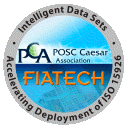| Version 1 (modified by jbourne, 16 years ago) |
|---|
TracNav menu
-
IDS-ADI Projects:
- ISO 15926 Primer
- ISO15926 Standard Structure
- IDS-ADI Coordination Structure
- IDS-ADI Infrastructure
- The AVALON Project
- Core Modelers Projects
- Core Implementers Projects
- Core Compliance Project
- Core Methodology Project
- IDS-ADI Matrix Master (login)
- IDS-ADI Matrix 1,2,3 activity
- IDS-ADI Matrix 4 activity
- IDS-ADI Matrix 8 activity
- IDS-ADI Part3 Harmonization
- IDS-ADI BIDG (aka Handover Guide)
- IDS-ADI Proteus Project

POSC-Caesar FIATECH IDS-ADI Projects
Intelligent Data Sets Accelerating Deployment of ISO15926
Realizing Open Information Interoperability
Modeling: Coarse-to-Fine Approach
A coarse-to-fine approach takes relationships that already exist in highly agglutinated or generalized forms and then may break them down into finer relationships in order to explore the structure of the data.
It is important to recognize that often they need not break them down much if at all - often, models built with this approach are purely for the recording of the data, without much emphasis placed on the analysis of the structure, beyond a certain level necessary to solve specific problems.
Constraints on the structure of the data
Coarse-to-fine approaches are typically empirical or based on actual data - they model information as it is recorded by humans or other systems. This exploits two very important features:
- it is often purpose-driven - the model fits the data because it has been developed as an abstraction of the patterns already in the data.
- it tends to reflect the way that humans think about the data in the disciplines that work with the problem set.
Most data model design processes follow this approach - not because it necessarily results in the best possible model, but because it quickly results in a model that fits the problem and the data fast.
Perhaps more importantly, it is popular because it is successful, and it is successful because it does not challenge the participants to alter the way they think about the structure of the data.
Note: this is not an obsequious comment - humans are not logical, humans think by making generalizations about observable patterns, and such generalizations need not be comprehensive; that is to say it is implicit that the generalizations are not intended to necessarily cover all cases. Human language is built to communicate these kinds of observable patterns or cases which fit them.
Frequently, this means that humans hold to lore that while useful, might not be correct. But its usefulness extends beyond its value as an approximation, or a rule of thumb - it is useful because human languages makes it concise to communicate to other humans (because human language is based on the same principles - generalizations not intended to be comprehensive in scope).
As a result, these kinds of approaches can only be used for interoperability where the problem-set is roughly shared across the communicating parties - that is to say, if one party wants to use this data to solve a different problem, there is a good chance it is actually useless to them.
